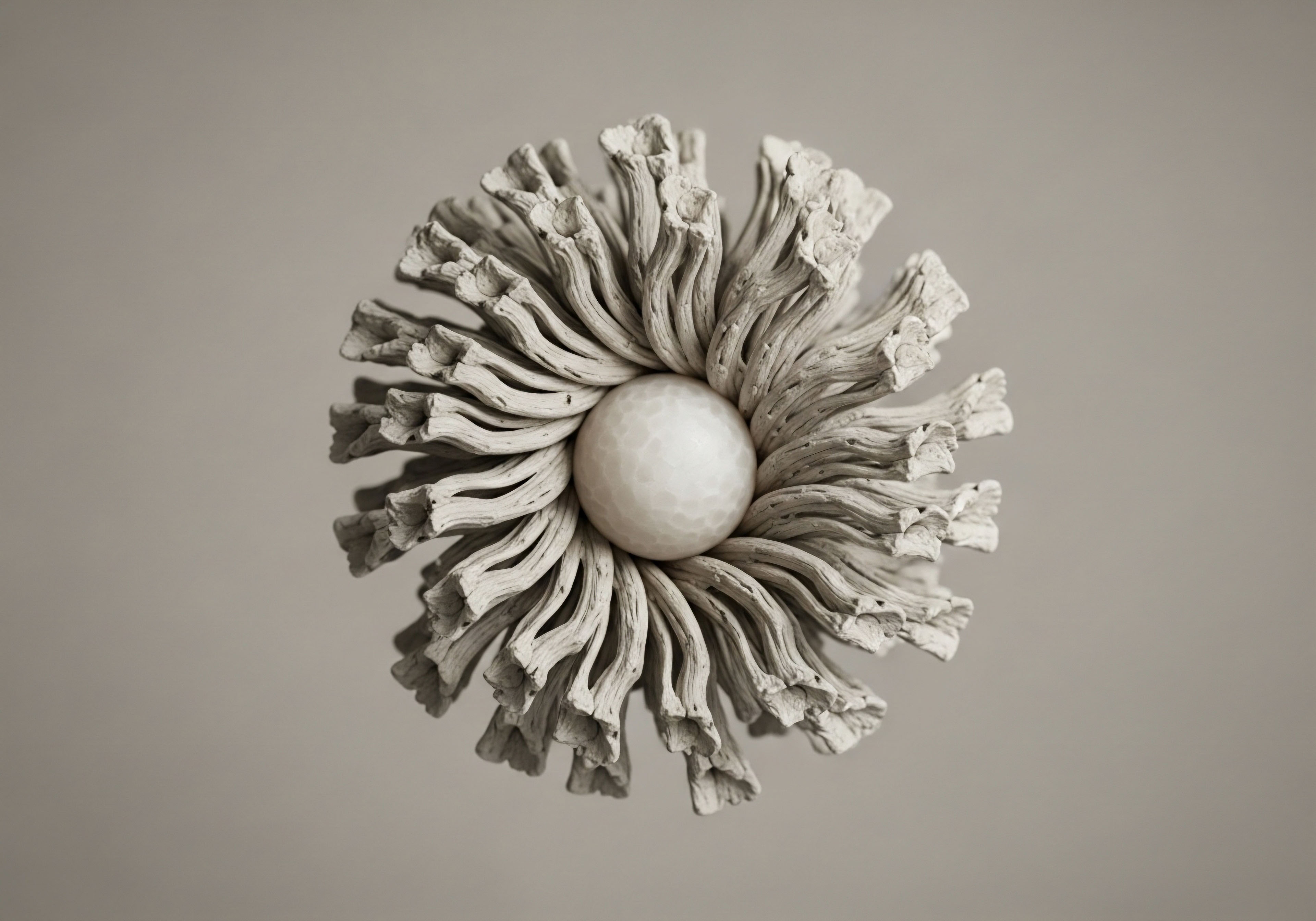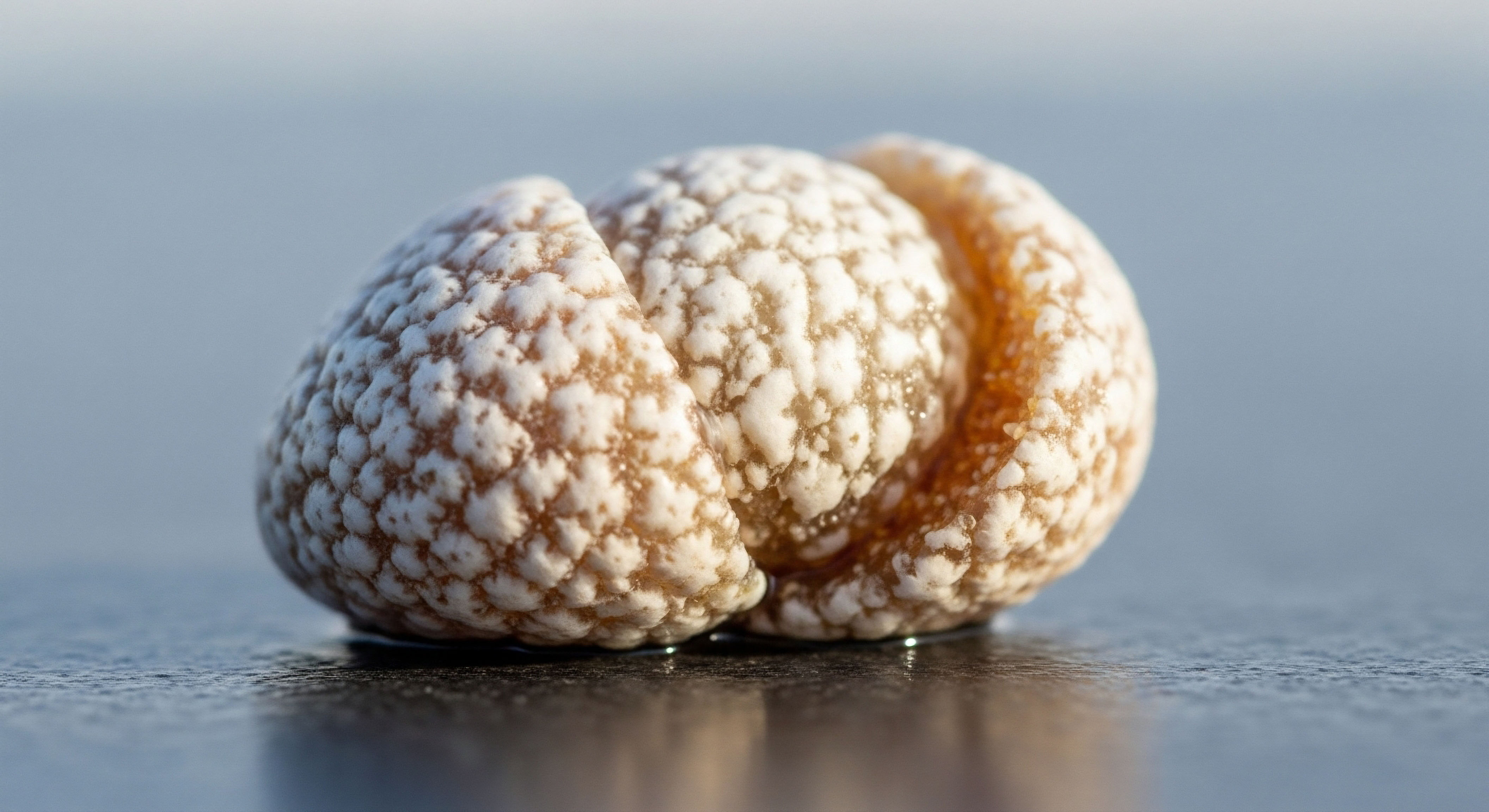

Fundamentals
You have made a conscious decision to take control of your biological systems, perhaps through a protocol of hormonal optimization. This is a path of proactive wellness, a choice to function at your peak. Yet, a critical question often surfaces, one that speaks to a fundamental aspect of our biology ∞ What about fertility?
The concern that in optimizing one system, you may have silenced another, is a valid and important consideration. The capacity to create life is a profound biological drive, and the thought of its diminishment deserves a clear, scientifically grounded exploration.
The human body operates on a series of elegant and responsive communication networks. The reproductive system is governed by one of the most important of these ∞ the Hypothalamic-Pituitary-Gonadal (HPG) axis. This is the central command structure for your natural production of sex hormones and for spermatogenesis, the process of creating sperm. Understanding this axis is the first step in understanding both suppression and restoration.

The Body’s Internal Dialogue
Imagine a highly efficient corporation. The hypothalamus, a small region at the base of the brain, acts as the Chief Executive Officer. It sends out a critical directive every 60 to 120 minutes. This directive is a hormone called Gonadotropin-Releasing Hormone (GnRH). This is not a continuous stream of information; its power lies in its rhythmic, pulsatile release. Each pulse is a specific order sent to the next level of management.
The pituitary gland, located just below the hypothalamus, is the Senior Manager. It receives the GnRH pulse and, in response, releases two essential hormones into the bloodstream:
- Luteinizing Hormone (LH) ∞ This hormone travels to the testes and signals the Leydig cells to produce testosterone. It is the primary driver of steroidogenesis, the creation of steroid hormones.
- Follicle-Stimulating Hormone (FSH) ∞ This hormone also targets the testes, specifically the Sertoli cells. These cells are the nurseries for sperm, and FSH is the signal that initiates and sustains sperm production.
The testes, in this analogy, are the production floor. They receive the LH and FSH signals and carry out their two primary functions ∞ producing testosterone and producing sperm. This entire system is regulated by a sophisticated feedback loop.
When testosterone levels in the blood are sufficient, they send a signal back to both the pituitary and the hypothalamus, telling them to slow down the release of GnRH, LH, and FSH. The system is designed for self-regulation, constantly adjusting to maintain balance.

The Consequence of External Signals
When you introduce exogenous testosterone, as in Testosterone Replacement Therapy (TRT), you are providing the body with a powerful, consistent signal of hormonal abundance. The HPG axis, with its sensitive feedback mechanisms, detects these high levels of testosterone. It interprets this state as an indication that the production floor is over-performing. Consequently, the hypothalamus dramatically reduces or completely ceases its pulsatile release of GnRH. The CEO stops sending orders.
The introduction of external testosterone quiets the body’s natural hormonal conversation, leading to a state of controlled suppression.
Without the GnRH signal, the pituitary gland has no instruction to release LH and FSH. The Senior Manager falls silent. This leads directly to the cessation of signals to the testes. The Leydig cells are no longer stimulated to produce testosterone, and the Sertoli cells are no longer instructed to support sperm production.
The result is a decline in testicular size and function, and a significant reduction or complete halt of spermatogenesis, leading to infertility. This state of suppression is a predictable and direct consequence of how the HPG axis is designed to function. The system is not broken; it is responding exactly as it should to the information it is receiving.
Understanding this mechanism is the foundation for reversing it. The question of restoring fertility is a question of restarting this elegant, internal dialogue. It involves strategically reintroducing the right signals to awaken each level of the command structure, from the CEO down to the production floor.


Intermediate
Reawakening the body’s innate capacity for fertility after a period of hormonal suppression is a process of systematic recalibration. The HPG axis, having been dormant, requires specific and targeted inputs to resume its natural, pulsatile function.
The protocols designed for this purpose are not a single intervention, but a carefully orchestrated sequence of pharmacological signals that speak the body’s own biochemical language. Each component has a distinct role in stimulating a different part of the HPG axis, with the collective goal of restoring both testosterone production (steroidogenesis) and sperm production (spermatogenesis).

How Do Restoration Protocols Work?
The core strategy involves stimulating the system from the top down or tricking it into action. We can either provide the initial command signal that has been missing or manipulate the feedback loops to convince the brain that production needs to ramp up. The primary tools for this process are Gonadorelin and Selective Estrogen Receptor Modulators (SERMs) like Clomiphene Citrate and Tamoxifen.

Gonadorelin the Direct Pituitary Stimulant
Gonadorelin is a synthetic version of the body’s own Gonadotropin-Releasing Hormone (GnRH). Its function is to directly replace the signal from the hypothalamus to the pituitary gland. During prolonged suppression, the hypothalamus has ceased its rhythmic GnRH pulses. Injecting Gonadorelin provides this missing signal, directly stimulating the pituitary to release Luteinizing Hormone (LH) and Follicle-Stimulating Hormone (FSH).
This action effectively bypasses the dormant hypothalamus and kick-starts the next step in the hormonal cascade. By re-engaging the pituitary, we send the necessary signals downstream to the testes to resume their function. Because natural GnRH is released in pulses, Gonadorelin is often administered in a similar pulsatile fashion, through small, frequent subcutaneous injections, to mimic the body’s natural rhythm and achieve a more physiological response.

SERMs the Indirect Stimulants
Selective Estrogen Receptor Modulators, or SERMs, work through a more indirect, yet powerful, mechanism. The primary agents used in male fertility restoration are Clomiphene Citrate (Clomid) and Enclomiphene Citrate. These compounds work at the level of the hypothalamus.
Estrogen, which is converted from testosterone in men, is a key part of the negative feedback loop that tells the hypothalamus to stop producing GnRH. Clomiphene works by blocking these estrogen receptors in the hypothalamus. The brain is effectively blinded to the circulating estrogen.
It interprets this lack of an estrogen signal as a sign that testosterone levels are critically low. In response, the hypothalamus begins to vigorously secrete GnRH to correct this perceived deficit. This, in turn, stimulates the pituitary to produce more LH and FSH, restarting the entire HPG axis. Enclomiphene is a specific isomer of clomiphene that is thought to have more of the desired antagonist effects on the estrogen receptor and fewer side effects, making it a more targeted option.
A fertility restoration protocol is a strategic sequence of signals designed to reawaken the body’s innate hormonal production pathway.

Comparing the Primary Restoration Agents
Choosing the right agent or combination of agents depends on the individual’s specific physiology, the duration of suppression, and the clinical goals. Each compound offers a different approach to stimulating the HPG axis.
| Agent | Mechanism of Action | Primary Target | Method of Administration |
|---|---|---|---|
| Gonadorelin | Directly mimics GnRH, stimulating the pituitary gland. | Pituitary Gland | Subcutaneous Injection |
| Clomiphene Citrate | Blocks estrogen receptors in the hypothalamus, increasing GnRH release. | Hypothalamus | Oral Tablet |
| Enclomiphene Citrate | A more targeted isomer of Clomiphene that blocks estrogen receptors. | Hypothalamus | Oral Tablet |
| Tamoxifen Citrate | Another SERM that blocks estrogen receptors, often used for its effects on gynecomastia and HPG axis stimulation. | Hypothalamus/Breast Tissue | Oral Tablet |

A Sample Post-TRT Fertility Restoration Protocol
A typical protocol is phased to ensure a smooth and effective restart of the system. The duration and dosages are always personalized under clinical supervision.
- Cessation of Exogenous Testosterone ∞ The first step is to remove the external signal that is causing the suppression. This allows the body to begin clearing the synthetic hormone.
- Initiation of HPG Axis Stimulants ∞ Shortly after the last testosterone injection, a protocol involving agents like Gonadorelin, Clomiphene, or a combination, is initiated. For instance, a protocol might involve:
- Clomiphene Citrate ∞ Often started at a dose of 25-50mg daily to begin stimulating the hypothalamus.
- Gonadorelin ∞ May be used concurrently, with injections administered multiple times per week to directly pulse the pituitary.
- Monitoring and Adjustment ∞ Blood work is essential. Levels of Total and Free Testosterone, LH, FSH, and Estradiol are monitored to assess the response. Semen analysis is performed after a couple of months to track the return of spermatogenesis.
- Optional Adjuncts ∞ In some cases, Anastrozole, an aromatase inhibitor, might be used cautiously if estrogen levels rise too high as a result of the increased testosterone production. However, some estrogen is necessary for healthy libido and sperm maturation, so its use is carefully managed.
This process of restoration is an active one. It requires patience and a deep understanding that you are working with your body’s complex systems, guiding them back to a state of self-regulating function. The goal is the return of a robust, independent hormonal rhythm capable of supporting full fertility.


Academic
A sophisticated analysis of fertility restoration post-suppression moves beyond simple hormonal replacement and into the domain of systems biology and pharmacodynamics. The successful recalibration of the Hypothalamic-Pituitary-Gonadal (HPG) axis is contingent upon a nuanced understanding of cellular physiology, the chronobiology of hormone secretion, and the differential effects of various therapeutic agents on the gonadotropic and steroidogenic pathways.
The central challenge lies in re-establishing the endogenous pulsatile secretion of gonadotropins, which is the essential prerequisite for synchronized testicular function, encompassing both Leydig cell steroidogenesis and Sertoli cell-mediated spermatogenesis.

The Molecular Basis of Gonadal Quiescence and Reactivation
Prolonged exposure to exogenous androgens induces a profound state of quiescence at multiple levels of the HPG axis. At the hypothalamic level, sustained high androgen and estrogen levels (via aromatization) suppress the frequency and amplitude of GnRH pulses from arcuate nucleus neurons. This gonadostat suppression results in diminished gonadotrope stimulation within the anterior pituitary.
Consequently, the synthesis and secretion of both LH and FSH are downregulated. The testes, deprived of their trophic support, undergo significant changes. Leydig cells become atrophic, reducing their capacity for testosterone synthesis. More critically for fertility, the Sertoli cells, which are entirely dependent on FSH and high intra-testicular testosterone concentrations, reduce their supportive function, leading to the arrest of germ cell maturation and a state of azoospermia or severe oligozoospermia.
Restoration protocols are designed to reverse this cascade. The administration of a SERM like Clomiphene Citrate functions as a competitive antagonist at the estrogen receptor alpha (ERα) sites within the hypothalamus. By preventing estradiol from binding, it disinhibits the GnRH pulse generator.
This is a powerful intervention, yet its efficacy can be influenced by individual variations in aromatase activity and receptor sensitivity. Gonadorelin administration presents a different pharmacodynamic profile. As a GnRH analogue, it directly activates pituitary GnRH receptors. The therapeutic success of Gonadorelin hinges on mimicking the endogenous pulsatile pattern. Continuous administration of a GnRH agonist paradoxically leads to receptor downregulation and further suppression. Therefore, low-dose, frequent subcutaneous administration is critical to elicit a physiological, stimulatory response from the gonadotropes.

What Factors Influence the Predictability of Fertility Restoration?
While protocols are generally effective, the timeline and completeness of recovery are subject to several variables. A quantitative understanding of these factors is essential for managing patient expectations and optimizing clinical strategies.
| Influencing Factor | Mechanism of Impact | Clinical Implication |
|---|---|---|
| Duration of Suppression | Longer periods of suppression may lead to more profound testicular atrophy and a lengthier period of Sertoli cell recovery. | Patients with multi-year TRT exposure may require longer restoration protocols. |
| Age of Patient | Baseline testicular reserve and Sertoli cell function decline with age. Older individuals may have a slower or less complete response. | Prognosis for recovery should be contextualized by age-related declines in reproductive function. |
| Concomitant HCG Use During TRT | The use of Human Chorionic Gonadotropin (HCG) during TRT mimics LH, maintaining Leydig cell function and intra-testicular testosterone levels. | Patients who used HCG during therapy often experience a significantly faster return of spermatogenesis as the testes have been kept partially active. |
| Baseline Fertility Status | Pre-existing subfertility or testicular dysfunction will impact the peak recovery potential. | A pre-TRT semen analysis provides a critical baseline for post-restoration assessment. |
| Genetic Factors | Polymorphisms in genes for gonadotropin receptors or steroidogenic enzymes can influence individual response to stimulation. | Genetic variability accounts for some of the observed differences in patient outcomes. |

Quantitative Outcomes and Clinical Endpoints
The primary clinical endpoint for fertility restoration is the achievement of a semen analysis sufficient for conception, typically defined as a sperm concentration greater than 15 million/mL with adequate motility and morphology. Clinical studies demonstrate a high rate of success, though timelines vary.
A significant portion of men can expect to see sperm return to the ejaculate within 3 to 6 months of initiating a post-TRT restoration protocol. Full restoration to baseline or conception-ready parameters may take 12 to 24 months. For example, some studies show that roughly 65% of men on TRT-induced azoospermia will recover spermatogenesis within 6 months, with that number rising to over 90% by 12 months.
However, a small percentage of men may experience persistent azoospermia, particularly if there was pre-existing testicular damage or an extremely prolonged period of suppression without supportive therapy like HCG.
The restoration of fertility is a biological process of revival, with a predictable trajectory influenced by the patient’s history and physiology.
The decision to use single-agent therapy versus a combination approach is also a key consideration. While Clomiphene alone can be effective, a combination protocol using both a SERM and a direct pituitary stimulant like Gonadorelin may offer a more robust, multi-pronged approach to restarting the entire axis simultaneously. This reflects a systems-based approach, acknowledging that intervening at multiple points in the cascade can yield a more rapid and comprehensive restoration of endogenous function.

References
- LIVV Natural. “TRT and Fertility ∞ How to Maintain Fertility While on Testosterone Therapy.” LIVV Natural, Accessed July 24, 2024.
- HRT Doctors Group. “HCG, Enclomiphene, & Gonadorelin – The Big Debate ∞ Which is Best at Maintaining Your Testosterone Production?” HRT Doctors Group, 17 Aug. 2024.
- Aspire Rejuvenation Clinic. “Human Chorionic Gonadotropin (HCG) Replacements For Men On Testosterone Therapy.” Aspire Rejuvenation Clinic, Accessed July 24, 2024.
- Habous, M. et al. “Clomiphene citrate and human chorionic gonadotropin are both effective in restoring testosterone in hypogonadism ∞ a short-course randomized study.” BJU International, vol. 122, no. 5, 2018, pp. 889-897.
- HRT Doctors Group. “Gonadorelin, hCG, and Clomiphene ∞ Which Is The Better Option?” HRT Doctors Group, 6 Sept. 2022.

Reflection
The information presented here provides a map of the biological pathways governing your fertility. It details the mechanisms of suppression and the clinically validated strategies for reawakening those systems. This knowledge transforms abstract concerns into a concrete understanding of cause and effect, process and potential. You now possess a framework for how the body’s internal communication can be paused and, crucially, how it can be restarted.
This map, however detailed, describes the general territory. Your own journey is unique, shaped by your individual physiology, history, and goals. The process of restoring a system as intricate as the HPG axis is a collaborative one, a partnership between your proactive engagement with your health and the guidance of a clinician who can interpret the specific signals your body is sending.
The ultimate objective is a state of elegant autonomy, where your body’s own systems are functioning with vitality and independence. The path forward begins with this understanding, empowering you to ask precise questions and make informed decisions on your personal health journey.

Glossary

spermatogenesis

pituitary gland

testosterone replacement therapy

hpg axis

selective estrogen receptor modulators

clomiphene citrate

gonadorelin

fertility restoration

estrogen receptor

estrogen receptors




